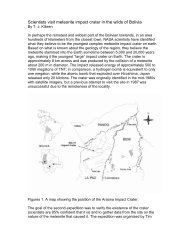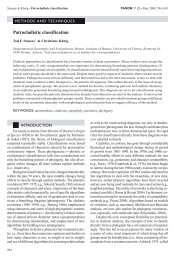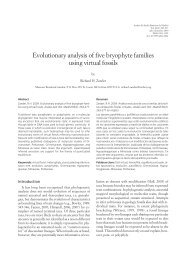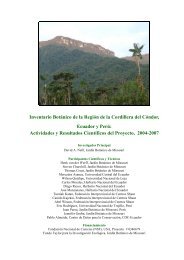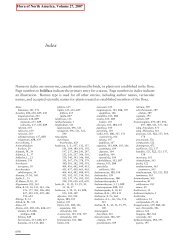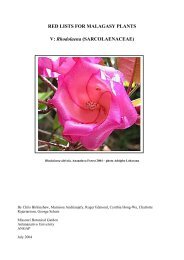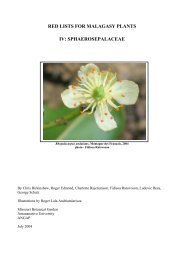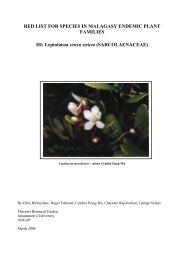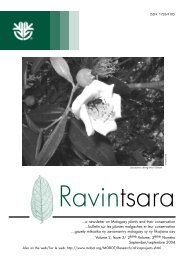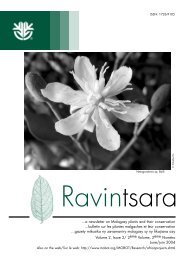phylogeny of campanulaceae s. str. inferred from its sequences of ...
phylogeny of campanulaceae s. str. inferred from its sequences of ...
phylogeny of campanulaceae s. str. inferred from its sequences of ...
You also want an ePaper? Increase the reach of your titles
YUMPU automatically turns print PDFs into web optimized ePapers that Google loves.
558 Annals <<strong>str</strong>ong>of</<strong>str</strong>ong> the<br />
Missouri Botanical Garden<br />
Table 3. Base composition and nucleotide divergence in the aligned partial <strong>sequences</strong> <<strong>str</strong>ong>of</<strong>str</strong>ong> ITS1 and ITS2 regions<br />
<<strong>str</strong>ong>of</<strong>str</strong>ong> nr DNA in the Campanulaceae.<br />
Sequence parameter ITS1 partial ITS2<br />
Aligned length<br />
Constant sites<br />
Variable sites<br />
Informative sites<br />
G C content (%)<br />
Unambig. transitions<br />
Unambig. transversions<br />
Ts/Tv ratio<br />
Avg. base frequencies*<br />
* Missing data and gaps excluded.<br />
PHYLOGENETIC ANALYSES<br />
A search for the most parsimonious tree was initiated<br />
using the PARSIMONY option <<strong>str</strong>ong>of</<strong>str</strong>ong> PAUP<br />
4.068 (Sw<<strong>str</strong>ong>of</<strong>str</strong>ong>ford, 2001) with ACCTRAN, MUL-<br />
TREES, TBR, and COLLAPSE ZERO LENGTH<br />
BRANCHES options. All characters were given<br />
equal weight and were unordered. Gaps were treated<br />
as missing data. The HEURISTIC search algorithm<br />
was chosen, with 1000 random addition replicates<br />
and with a limit <<strong>str</strong>ong>of</<strong>str</strong>ong> 2000 trees saved per<br />
replicate. The amount <<strong>str</strong>ong>of</<strong>str</strong>ong> support for monophyletic<br />
groups was evaluated by 1000 boot<strong>str</strong>ap replicates<br />
and a 50% cut-<<strong>str</strong>ong>of</<strong>str</strong>ong>f value for the boot<strong>str</strong>ap consensus<br />
tree (Felsenstein, 1985). Consistency Indices (CI)<br />
(Kluge & Farris, 1969) were also computed. The<br />
Retention Index (RI) and the g1 statistic (Hillis &<br />
Huelsenbeck, 1992) were also computed, the latter<br />
after computing the tree-length di<strong>str</strong>ibution <<strong>str</strong>ong>of</<strong>str</strong>ong><br />
100,000 random parsimony trees by means <<strong>str</strong>ong>of</<strong>str</strong>ong> the<br />
RANDOM TREES command.<br />
RESULTS AND DISCUSSION<br />
The total aligned length <<strong>str</strong>ong>of</<strong>str</strong>ong> the ITS1 and partial<br />
ITS2 (including gaps) was 497 bp. There were 81<br />
constant characters, 71 variable characters that<br />
were parsimoniously uninformative, and 345 parsimoniously<br />
informative characters (Table 3). Parsimony<br />
analyses generated 2629 trees with 2130<br />
steps, a CI <<strong>str</strong>ong>of</<strong>str</strong>ong> 0.3703 (excluding uninformative<br />
characters), and RI <<strong>str</strong>ong>of</<strong>str</strong>ong> 0.7583 (Figs. 1, 2). The g1<br />
statistic for 100,000 trees randomly sampled was<br />
0.327694 indicating that the ITS data set is significantly<br />
skewed <strong>from</strong> random and contains considerable<br />
phylogenetic information (Hillis & Huelsenbeck,<br />
1992). For other statistics <<strong>str</strong>ong>of</<strong>str</strong>ong> the aligned<br />
<strong>sequences</strong> see Table 3. Multiple ITS types were not<br />
detected, and in one case there were two separate<br />
samples <<strong>str</strong>ong>of</<strong>str</strong>ong> the same species (Adenophora divaricata<br />
Franch. & Sav.) that did not come out together. The<br />
497<br />
81<br />
416 (75 uninformative)<br />
345<br />
59.8<br />
627<br />
500<br />
1.254<br />
A 20.8 C 30.6 G 29.2 T 19.3<br />
branch lengths are very short for the Adenophora<br />
clade overall, which indicates that most <<strong>str</strong>ong>of</<strong>str</strong>ong> the species<br />
have very similar ITS <strong>sequences</strong>. The differences<br />
between the two samples <<strong>str</strong>ong>of</<strong>str</strong>ong> A. divaricata suggest<br />
either misidentification <<strong>str</strong>ong>of</<strong>str</strong>ong> the original sample<br />
or population differences in the ITS <strong>sequences</strong>.<br />
The taxonomic categories used in classifications<br />
are unequivocal and the amount <<strong>str</strong>ong>of</<strong>str</strong>ong> molecular divergence<br />
(and hence phylogenetic signal) within<br />
and between taxa at each level in the taxonomic<br />
hierarchy varies. For a family such as the Campanulaceae,<br />
which has numerous monophyletic genera<br />
and sections, the use <<strong>str</strong>ong>of</<strong>str</strong>ong> ITS <strong>sequences</strong> is justified<br />
by the phylogenetic signal obtained, but there may<br />
be substantial trade-<<strong>str</strong>ong>of</<strong>str</strong>ong>f due to problems with alignments.<br />
The difficulties associated with sampling<br />
across a wide spectrum <<strong>str</strong>ong>of</<strong>str</strong>ong> taxa in the Campanulaceae<br />
should lessen as we are able to refine our<br />
molecular analyses at different levels in the taxonomic<br />
hierarchy, in conjunction with other sources<br />
<<strong>str</strong>ong>of</<strong>str</strong>ong> data. Due to high ambiguity at the generic level<br />
in the Campanulaceae, ITS sequence data may be<br />
approaching the lim<strong>its</strong> <<strong>str</strong>ong>of</<strong>str</strong>ong> usefulness for phylogenetic<br />
recon<strong>str</strong>uction, whereas at the species level,<br />
there may not be enough signal, and many species<br />
may be spuriously placed with each other. For extensive<br />
discussion <<strong>str</strong>ong>of</<strong>str</strong>ong> the utility and limitations <<strong>str</strong>ong>of</<strong>str</strong>ong><br />
the ITS region in the recon<strong>str</strong>uction <<strong>str</strong>ong>of</<strong>str</strong>ong> angiosperm<br />
<<strong>str</strong>ong>phylogeny</<strong>str</strong>ong>, see Baldwin et al. (1995), Coleman<br />
(2003), and Goertzen et al. (2003).<br />
MAJOR CLADES IN THE ITS TREE<br />
The topology <<strong>str</strong>ong>of</<strong>str</strong>ong> the <strong>str</strong>ict consensus tree (Fig. 1)<br />
shows that there are two major clades <<strong>str</strong>ong>of</<strong>str</strong>ong> the Campanulaceae.<br />
This major dichotomy in the family is<br />
supported by pollen data. For convenience, these<br />
two major clades are referred to as alliances and<br />
are named on the basis <<strong>str</strong>ong>of</<strong>str</strong>ong> their pollen types. The<br />
taxa in the smaller <<strong>str</strong>ong>of</<strong>str</strong>ong> these two alliances comprise





